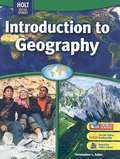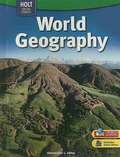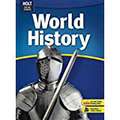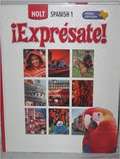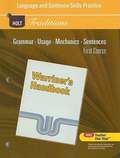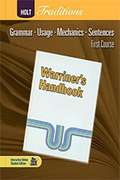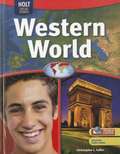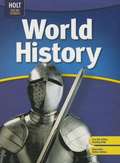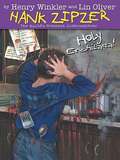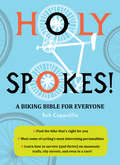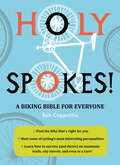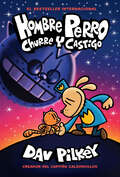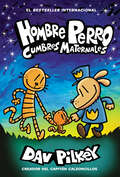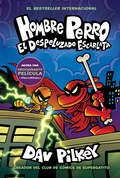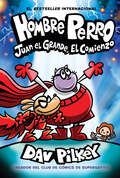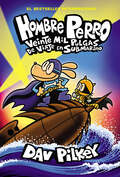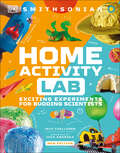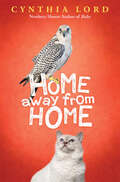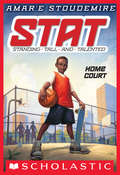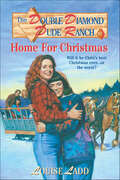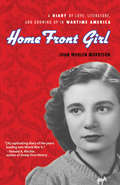- Table View
- List View
Holt Social Studies: Introduction to Geography
by Christopher L. SalterHolt Social Studies: Introduction to Geography is a ticket to the exciting world of geography.
Holt Social Studies: World History
by Richard Shek Stanley M. BursteinStudying world history will be easy for students using this textbook. With the easy-to-use structure and special features, this textbook will make history come alive for the students.
Holt Spanish 1, ¡Exprésate! (Grade 7, Texas Edition)
by Ana Beatriz Chiquito John Mcminn Stuart Smith Sylvia Madrigal Velasco Nancy A. HumbachAn English Spanish learning text book
Holt Traditions, Language and Sentence Skills Practice, First Course
by Rinehart And Winston Staff HoltNIMAC-sourced textbook
Holt Traditions, Warriner's Handbook: First Course
by John E. WarrinerThis book can be used as a complete grammar, usage, and mechanics textbook, and also as a reference guide when you work on any piece of writing. Whether you are writing a personal letter, a report for your social studies class, or some other piece of writing, you can use the Holt Handbook to answer your questions about grammar, usage, capitalization, punctuation, and spelling.
Holt Western World
by Christopher L. SalterThis book is all about geography and history of the Western world along with test taking strategies.
Holt World History
by Richard Shek Stanley BursteinThis textbook uses both primary and secondary sources to make students better historians.
Holt: Louisiana Practice and Enrichment, First Course
by Rinehart Winston HoltNIMAC-sourced textbook
Holy Enchilada! (Hank Zipzer, the World's Greatest Underachiever #6)
by Henry Winkler Lin Oliver Tim HeitzPS 87 is having multicultural week, and Ms. Adolf's class is putting on a "Foods from Around the World" luncheon. Hank is thrilled, no reading, no outlining, and no review questions, just cooking! Hank makes enchiladas, and at the luncheon, Ms. Adolf piles her plate with lots of food. But after a few bites, her face turns bright red. One of the dishes is super-spicy! <p>Ms. Adolf accuses someone of playing a mean practical joke, and punishes the entire class with no recess until the guilty party comes forward. Hank realizes his trouble with numbers might have caused the problem. What if he accidentally used three cups of peppers instead of 1/3 cup? Will Hank be able to get recess back for everyone without getting detention for the rest of his life? <p> <p><b>Lexile Level: 750L</b></p>
Holy Spokes!
by Rob CoppolilloBiking is cheap, it's healthy, and it can provide easy access into an incredible array of life experiences. In this wide-ranging and quick-hitting guide, author Rob Coppolillo explains how bikes work, why bikes matter (especially today, when gas is expensive and interest in green living is high), and how readers - whatever their level of experience - can indulge their tastes for mountain trails, competitive racing, city exploration, and just basic transportation from point A to point B. Profiles from a raucous cast of health, racing, and travel experts shed a light on common pitfalls, and offer great ideas about how to pursue your passions while on two wheels. So take the quiz, pick your bike, and let's get rolling!
Holy Spokes!: A Biking Bible for Everyone
by Rob CoppolilloBiking is cheap, healthy, and can provide easy access into an incredible array of life experiences. In this wide-ranging and quick-hitting guide, author Rob Coppolillo explains how bikes work, why bikes matter (especially today, when gas is expensive and interest in green living is high), and how readers—whatever their level of experience—can indulge their tastes for mountain trails, competitive racing, city exploration, and basic transportation from point A to point B. Profiles from a raucous cast of health, racing, and travel experts shed light on common pitfalls and offer great ideas on pursuing your passions while on two wheels. So take the quiz, pick your bike, and let's get rolling!
Hombre Perro: Churre y castigo (Hombre Perro)
by Dav PilkeyThe mayor has had enough of Dog Man's shenanigans in the ninth book from worldwide bestselling author and artist Dav Pilkey.¡Hombre Perro ha metido la pata hasta el fondo esta vez! Tiene que entregar su placa y vaciar el escritorio, pero si bien no tiene trabajo aún le quedan esperanzas. Con sus amigos de su lado, ¿podrá Hombre Perro salir del hoyo y regresar gateando al cuerpo policial?Dog Man's really done it this time! He hands over his badge and clears out his desk, but while he may be out of a job, he's not yet out of hope. With his friends at his side, can Dog Man dig himself out of this hole and paw his way back onto the force?
Hombre Perro: Cumbres maternales (Hombre Perro)
by Dav PilkeyDog Man and Petey face their biggest challenges yet in the tenth Dog Man book from worldwide bestselling author and illustrator Dav Pilkey.A Hombre Perro se le acaba la suerte, Pedrito confronta su pasado no tan perfecto y el abuelo anda haciendo de las suyas. El mundo está fuera de control con los nuevos villanos que han llegado a la ciudad. La situación se ve oscura y sin esperanzas. Sin embargo, no todo está perdido. ¿Podrá arreglar las cosas el increíble poder del amor?Dog Man is down on his luck, Petey confronts his not so purr-fect past, and Grampa is up to no good. The world is spinning out of control as new villains spill into town. Everything seems dark and full of despair. But hope is not lost. Can the incredible power of love save the day?
Hombre Perro: El Despeluzado Escarlata (Hombre Perro)
by Dav Pilkey¡Nuestro superhéroe canino regresa en DOG MAN: THE SCARLET SHEDDER, la duodécima novela gráfica llena de suspense y divertidísima de la serie número uno en ventas mundiales del galardonado autor e ilustrador Dav Pilkey!¡Qué peste! ¡Hombre Perro ha sido rociado por un zorrillo! Tras sumergirlo en jugo de tomate el olor desaparece, pero el color rojo escarlata no se le quita. ¡Este valiente superhéroe, ahora exiliado, debe luchar para salvar a los ciudadanos que lo rechazaron! ¿El fin justificará los medios para Pedrito, quien a regañadientes regresa a la vida del crimen para ayudar a Hombre Perro? ¿Y quién dará un paso al frente cuando un villano completamente nuevo y nunca antes visto desate un ejército de robots de I.A.?Our canine superhero returns in DOG MAN: THE SCARLET SHEDDER, the suspenseful and hilarious twelfth graphic novel in the #1 worldwide bestselling series by award-winning author and illustrator Dav Pilkey!P.U.! Dog Man got sprayed by a skunk! After being dunked in tomato juice, the stink is gone but the scarlet red color remains. Now exiled, this spunky superhero must struggle to save the citizens who shunned him! Will the ends justify the means for Petey, who's reluctantly pulled back into a life of crime in order to help Dog Man? And who will step forward when an all-new, never-before-seen villain unleashes an army of A.I. robots?
Hombre Perro: Juan el Grande, el comienzo (Hombre Perro)
by Dav Pilkey¡El superhéroe favorito de todos está de vuelta en la emocionante decimotercera novela gráfica de la serie más exitosa del galardonado autor e ilustrador Dav Pilkey! Es heroico, sincero y divertidísimo: ¡es Hombre Perro!¡Sigue a Hombre Perro y a tus súper favoritos amigos mientras salvan la ciudad de un nuevo y malvado malhechor! Para aventuras de novelas gráficas más sentidas, sigue a Aleta y a Peque Pedrito en la serie El Club de Cómics de Supergatito. Y no olvides la serie que lo empezó todo: ¡El Capitán Calzoncillos!Everyone's favorite superhero is back in the thrilling thirteenth graphic novel in the #1 worldwide bestselling series by award-winning author and illustrator Dav Pilkey! It's heroic, it's heartfelt, it's hilarious -- it's Dog Man!Join Dog Man and your favorite supa buddies as they save the city from a dastardly new wrongdoer! For more heartfelt graphic novel adventures, join Flippy and Li'l Petey in the Cat Kid Comic Club series. And don't forget the series that started it all: Captain Underpants!
Hombre Perro: Veinte mil pulgas de viaje en submarino (Hombre Perro)
by Dav PilkeyDOG MAN IS BACK! The highly anticipated new graphic novel in the #1 worldwide bestselling series starring everyone's favorite canine superhero by award-winning author and illustrator Dav Pilkey!Piggy está de vuelta, y su nuevo plan es el más diabólica hasta el momento. ¿QUÉ nuevos villanos hay en el horizonte? ¿DE DÓNDE salieron? Y ¿QUIÉN dará un paso adelante para salvar a la ciudad cuando los sinvergüenzas saboteen a nuestros superamigos? Hombre Perro: Veinte mil pulgas de viaje en submarino, con sus temas de amistad y de hacer el bien, está lleno de acción y risas. Incluye un "Mordiscorama", una nueva canción, un ácaro monstruoso y ¡mucho más que antes! ¡ES HERÓICO, ES ÉPICO!Piggy has returned, and his newest plot is his most diabolical yet. WHAT other new villains are on the horizon? WHERE are they all coming from? And WHO will step forward to save the city when scoundrels sabotage our Supa Buddies? With themes of friendship and doing good, Dog Man: Twenty Thousand Fleas Under the Sea is packed with action and hilarity. Featuring "Chomp-O-Rama," a brand-new song, a monstrous Mighty Mite -- and so much more than ever before! IT'S HEROIC, IT'S EPIC!
Home Activity Lab: Exciting Experiments for Budding Scientists (DK Activity Lab)
by Robert WinstonDive into science with these fun and simple experiments for children to do at home.This fun, activity-filled book is brimming with home experiments to help budding scientists aged 8-14 explore different projects. Using household items, combine science with art and craft, and make an erupting volcano, design rubber band planets, sail a soap-powered boat, and race car balloons.Packed with photography, easy-to-follow instructions, and attention to detail, Home Activity Lab will excite young scientists from the get-go! Each of the super-fun make-and-do projects in this book comes with simple step-by-step photographs and instructions that will inspire children&’s imagination and teach STEM topics.This children&’s craft book on space offers: - 28 hands-on projects that appeals to kids aged 8-14.- Materials easily found around the home with no specialist equipment needed.- Information boxes full of fascinating facts and panel stories that explain the science throughout the book.- A clear explanation how STEM is involved in creating the project or the results of the experiment.Ideal for kids who are interested in STEM, Home Activity Lab features a collection of science projects with easy-to-follow instructions and everyday ingredients that can be found around the house. Each experiment describes the science behind the project, highlighting STEM facts with STEM icons pointing out the key science, technology, engineering, and maths learning involved in each one.More in the seriesThe Activity Lab series inspires children to get hands-on with learning by creating exciting STEM projects in their favorite subject. If you liked Home Activity Lab, then why not try Dinosaur Activity Lab for budding paleontologists, Cardboard Activity Lab for eco-friendly recycling fun, Space Activity Lab for aspiring astrologists, or Great STEM Projects experiments for all budding scientists?
Home Alone
by Todd StrasserKevin's day gets off to a bad start, when his family forgets him as they go to Paris for the holidays. Then there are burglars in the neighborhood.
Home Away From Home
by Cynthia LordFrom Newbery Honor Winner Cynthia Lord, a brilliant story about how to find home when everything around us is changing.Mia and her mom visit Grandma in Maine every summer, but this year Mia is going alone. Her mom will stay behind to get their house ready to sell. It’ll be a new start, she says, after the divorce.Mia doesn’t want a new start. She’d rather everything just stayed the same! At least things will be the same at Grandma’s, though. Mia will walk to town for ice cream, and wait by the water, watching for birds, just like always.Then Mia meets Grandma’s know-it-all new neighbor, who’s just her age. Cayman acts like he belongs at Grandma’s house. He acts like he’s the expert on everything. And when he and Mia spot an unusual white bird of prey, he acts like it’s his job to find out what it is.Unless, that is, Mia finds out first. And, in her effort to prove herself to him, she makes a decision that will change things for the town, for the bird, for Cayman, and even for herself. Can Mia stop what she’s put into motion?Acclaimed author Cynthia Lord, with her trademark sensitivity, weaves her love of nature with a profound reflection on what it means to be at home in a changing world.
Home Court: Standing Tall and Talented #1) (STAT #1)
by Amar'e StoudemireSTAT: Standing Tall And Talented-- A slam-dunk new fiction series from NBA superstar Amar'e Stoudemire!Eleven-year-old Amar'e Stoudemire has a lot going on. He loves to go skateboarding in the park. He takes his school work very seriously. He helps out with his dad's landscaping company. And he likes to play basketball with his best friends-but just for fun. When a group of older kids start disrespecting his boys on their neighborhood basketball court, there is only one solution. Amar'e must step in and use his athletic ability and intelligence to save the day. This experience leads Amar'e to realize that basketball is his true passion.Based on the life of All-Star NBA sensation Amar'e Stoudemire, who overcame many obstacles to become one of the most popular figures in sports today. Amar'e is just as versatile in his off the court life as he is on. He is devoted to several charities. He promotes literacy and education. He is a media darling. And he has an amazing story to tell in this heartfelt, accessible middle-grade series.
Home For Christmas (The Double Diamond Dude Ranch)
by Louise LaddWill it be Chris's best Christmas ever . . . or the worst?Home for Christmas by Louise LaddIt's Christmas at the Double Diamond Dude Ranch. And this year should be the best Christmas ever. Chris's mom is coming home! Ever since her parents separated and her mother resumed her singing career, Chris hasn't had much time with her. But Glorinda Lee has decided to take a break from her Nashville tour as a country-western star to spend the holidays with Chris. Chris can't wait. Having her mom home for the holidays is the best present Chris could have asked for. There's only one problem: Chris's father has invited his new girlfriend to spend Christmas at the Double Diamond, too. What if she and Glorinda Lee don't get along?For Chris, her best Christmas ever could quickly turn into a disaster!Don't miss other exciting Chris adventures!At the Publisher's request, this title is being sold without Digital Rights Management Software (DRM) applied.
Home Front Girl: A Diary of Love, Literature, and Growing Up in Wartime America
by Susan Signe Morrison Joan Wehlen MorrisonWednesday, December 10, 1941"Hitler speaks to Reichstag tomorrow. We just heard the first casualty lists over the radio. . . . Lots of boys from Michigan and Illinois. Oh my God! . . . Life goes on though. We read our books in the library and eat lunch, bridge, etc. Phy. Sci. and Calculus. Darn Descartes. Reading Walt Whitman now." This diary of a smart, astute, and funny teenager provides a fascinating record of what an everyday American girl felt and thought during the Depression and the lead-up to World War II. Young Chicagoan Joan Wehlen describes her daily life growing up in the city and ruminates about the impending war, daily headlines, and major touchstones of the era--FDR's radio addresses, the Lindbergh kidnapping, Goodbye Mr. Chips and Citizen Kane, Churchill and Hitler, war work and Red Cross meetings. Included are Joan's charming doodles of her latest dress or haircut reflective of the era. Home Front Girl is not only an entertaining and delightful read but an important primary source--a vivid account of a real American girl's lived experiences.

